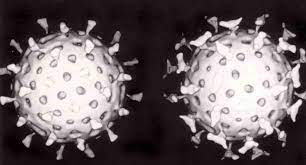Abstract
The VP8* domain of spike protein VP4 in group A and C rotaviruses, which cause epidemic gastroenteritis in children, exhibits a conserved galectin-like fold for recognizing glycans during cell entry. In group B rotavirus, which causes significant diarrheal outbreaks in adults, the VP8* domain (VP8*B) surprisingly lacks sequence similarity with VP8* of group A or group C rotavirus. Here, by using the recently developed AlphaFold2 for ab initio structure prediction and validating the predicted model by determining a 1.3-Å crystal structure, we show that VP8*B exhibits a novel fold distinct from the galectin fold. This fold with a β-sheet clasping an α-helix represents a new fold for glycan recognition based on glycan array screening, which shows that VP8*B recognizes glycans containing N-acetyllactosamine moiety. Although uncommon, our study illustrates how evolution can incorporate structurally distinct folds with similar functionality in a homologous protein within the same virus genus.
Introduction
Rotaviruses are non-enveloped icosahedral double-stranded RNA (dsRNA) viruses belonging to the Reoviridae family1. These viruses exhibit enormous genetic and serological diversity. Based on the sequence and antigenic differences of the capsid protein VP6, they are classified into ten different species or groups (A–J)2,3. Group A, B, C, and H rotaviruses infect both humans and animals4,5. Epidemiologically, groups A, B, and C are the best characterized. While group A rotaviruses (RVA) and to a lesser extent group C rotaviruses (RVC) are the causative agents of most gastroenteric infections worldwide, the group B rotaviruses (RVB) have been associated with large epidemic outbreaks of severe gastroenteritis in China6,7 and sporadic infection in several countries8,9,10. Unlike RVA, which infects mainly young children, RVB causes cholera-like severe diarrhea predominantly in adults, although children can be infected as well8. Antibodies to the RVB have been detected in people in developed countries such as the USA, Canada, and the UK11,12, indicating a broader prevalence of RVB. RVB also infects animals and caused recent hemorrhagic diarrheal outbreaks in piglets and foals, resulting in significant economic impact and posing a threat of potential zoonotic transmission13,14. Considering that these rotaviruses have segmented dsRNA genomes, with a propensity for evolving by gene reassortment from co-infections and mutations, the potential for the emergence of new variants that can cause severe epidemics cannot be discounted. A case in point is the current ongoing global COVID-19 pandemic caused by SARS-CoV-215.
Like RVA, which remains the best characterized thus far, and RVC, the genome of RVB consists of 11 dsRNA segments that encode 11 proteins16. Cryo-EM reconstructions of RVA have shown that trimers of VP4 form 60 protruding spikes attached to the outer VP7 and middle VP6 layers of the triple-layered capsid17,18,19. The proteolytic treatment of VP4, which significantly enhances infectivity, results in two fragments, VP8* and VP5*, that remain associated with the virion. Sequence comparison of the structural proteins encoded by different rotavirus groups shows that the VP8* domain of the spike protein VP4 is the most variable20. Extensive structural studies have shown that the galectin-like VP8* of human RVA and RVC (VP8*A and VP8*C) recognize various cellular glycans in a genotype-dependent manner (Fig. 1a, b)21,22,23,24,25,26,27,28,29. The VP8* of human RVA exhibits genotype-dependent glycan specificity by recognizing different histo-blood group antigens (HBGA)30. Differential recognition of HBGA has provided a possible rationale for why some RVAs specifically infect neonates, and some cause sporadic outbreaks while others infect a wider population22,23,24,31. Unlike the VP8*A and VP8*C, the structure of VP8*B and its glycan specificity have not been characterized. The VP8*B shares no sequence identity with either VP8*A or VP8*C (Supplementary Fig. 1a and Supplementary Table 1), which could differentially impact not only the structure but also the glycan-binding properties. Here we show by determining the crystal structure of VP8*B, using a model predicted using the recently developed AlphaFold2, that the VP8*B exhibits a fold with a twisted β-sheet clasping an α-helix that is entirely different from VP8*A or VP8*C. Our glycan array screening and in silico docking analysis show VP8*B recognizes glycans containing N-acetyllactosamine exemplifying how viruses can evolve by incorporating structurally distinct modules with similar functionality….







